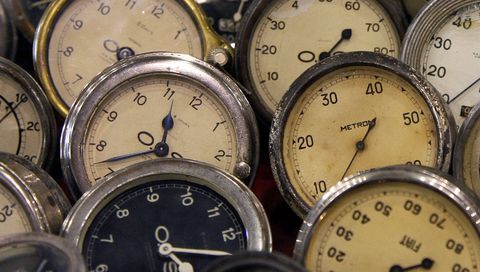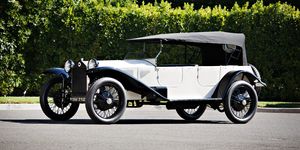
Given the crossover between people who like classic cars and those who like other complicated devices in general—and vintage wristwatches specifically—it’s a little surprising that the car clock often goes completely neglected during the automotive recommissioning process.
Our Murilee Martin has amassed a huge assortment of the things, sure, but an informal survey of Autoweek editors reveals that exactly none of us has functioning clocks in our pre-quartz era (it’s totally a thing, like brass era or nickel era, I swear) classic cars. I suspect a lot of you reading this are in the same boat.
Since car clocks occupy a substantial piece of dashboard real estate, and are by design highly visible, this isn’t exactly an “out of sight, out of mind” situation. Instead, it seems that when faced with all of the other challenges of keeping an aging car on the road—and for occasional use, at that—it’s one of those things that remains at the bottom of the to-do list more or less perpetually. A functional clock won’t make your car run any better.
But behind a vintage car clock’s fancy hands and dials, and behind its straightforward timekeeping function, there are some interesting mechanisms at play.
The earliest car clocks were, predictably enough, fully spring-driven; depending on how you look at it, they were either like scaled-up pocket watches or scaled-down mantel clocks. Like any basic spring-driven mechanical clock, you had to wind them periodically—or, since they typically went in high-end cars like Rolls-Royces and Packards, you relied on your chauffeur/mechanic to ensure that they were always appropriately wound.
After World War II, electromechanical clocks—or more accurately, electric remontoire clocks—came to dominate the automotive timekeeping scene. Like their hand-wound predecessors, these clocks still keep time via conventional balance wheel-regulated movements, but their drive spring—the “remontoire,” or secondary source of power—is rewound at regular intervals by a solenoid. This solenoid is powered by the car’s accessory electrical system (or battery, if the car was not running), and it fires every minute or two to do its spring-winding duty.
This might, at first, seem like a needless complication (not that watch enthusiasts have anything against needless complications …). Why didn’t automakers use a version of the simple, reliable, fully electric clocks such as were commonly found in households starting in the 1930s?
It’s because these timepieces, known as “synchronous clocks,” use the frequency of the power grid (60 Hz, in America’s case) to keep time. This is an elegant setup, but one that requires an alternating current power supply to function; car accessory systems function on direct current. Until quartz came along, the electromechanical mechanism was the most hands-off approach to reliable onboard automotive timekeeping. Other mechanisms did exist, but the electromechanical setup was by far the most common.
To figure out why old car clocks never seem to work, and what it takes to bring them back to life, I called up Jerry Magayne of The Clock Works (one of a number services that will get your defunct automotive timepiece back up and running). Operating out of Wisconsin, The Clock Works started as a sideline operation in the mid-1980s, but became a full business in 1988; Magayne says he’s personally handled 36,000 clocks over the years. When we spoke on a Friday afternoon, he’d just been working on a clock from a ’62 Ford Thunderbird.
“It’s usually the last thing that people think of, and it’s the one thing that stands out—you see a lot of great cars at shows and auctions, and a lot of times the clock doesn’t work,” Magayne says. “And that to me says that something was overlooked.” Hence his business’ motto: “The job’s not finished until the clock works.”
As for what goes wrong, he says, “There’s a combination of things. (Lack of lubrication) is one. These clocks were never designed to be maintenance-free; they were meant to be cleaned and oiled periodically like any other mechanical clock of the era. Nowadays, with digital clocks and quartz clocks, we’re spoiled—everything is maintenance-free, and once it stops working you throw it away and get a new one.
“The manufacturers normally recommended regular service on the clock, but once the car was 2 or 3 years old, the clock was the last thing you had to worry about; there were more important things. So once they stopped working, they were usually forgotten, just left in the dashboard as a static display.” By the time an old car has entered a collector’s garage, the damage caused by neglect has already been done.
“If a clock is at the point where it has stopped running, there’s usually going to be some wear in the plates,” which you can think of as a sort of chassis for the clock’s movement. “The clock will run without lubrication, but what happens is, the parts wear—it’s just like running your engine without engine oil in it. When the oil disappears and wear starts to occur, parts start to drift out of alignment as pivot holes become elongated. Parts will start to drift, and the clock will start to run erratically until the gears bind up. In that case, what we have to do is repair or replace the plates.”
Every clock that enters Magayne’s shop gets torn down and rebuilt—there’s no sense in troubleshooting them first. “Once you’ve done this many clocks, it becomes fairly routine. I could probably tear a complete clock down, service it and get it back together again in an hour. We keep things moving along here. Normally, we have maybe a one to two week backlog, but we do have an express service where we can get them out in a day or two” for a modest premium, he says.
It helps that The Clock Works keeps a large supply of new-old stock and salvaged parts on hand—and that there’s a great deal of commonality across makes and models. “Most of the clocks from the ’30s, right up until the ’70s and ’80s, were made by two or three suppliers,” Magayne explains. “There were a few oddball companies that got into auto clocks, maybe dabbled in them—Delco did their own clocks for a few years in the ’50s, and Hamilton Watch built clocks—but the majority of clocks were made by Borg or Westclox. Those were the two primary automotive suppliers … a lot of the clocks came from the same factory, from the same manufacturer.”
If there’s any trouble, it’s usually in tracking down correct dials or hands rather than guts—unless, Magayne says, it’s a Delco clock found on an early Corvette, or a Smiths clock such as you’d find on classic British cars. Those have parts that are difficult, if not impossible, to track down these days, and so the mechanism itself must be replaced by a different mechanical movement or swapped with a quartz clock.
Once your clock is back up and running, a little bit of extra effort is needed to keep it healthy. “I have a clock in my personal car that I just pulled out that’s been running for 30 years. There are certain things you need to do to get a clock to run that long. The biggest thing is, disconnect the battery when you’re not running the car,” Magayne says. For one, he explains, there are only so many cycles built into the clocks before they start to wear out—they tended to be built to a price, rather than a standard.
Another reason to disconnect the battery: “Low voltage will kill the clock quicker than anything. If the points inside don’t have enough juice to fire (the solenoid) and wind the clock, the points stay closed, and there’s a coil in there that will overheat and burn out. Probably 50 percent of the clocks we see have burned coils because people ran them on low battery.”
And what about the ambitious DIYer? “If you have some aptitude, and you’re good with small parts, there’s no law that says you can’t work on your own clock,” Magayne says. “The problem that you’re going to run into is finding parts. Because a lot of the clocks are going to have worn plates and worn points and burned coils and other parts not accessible to the average person, unless you have a spare clock you can borrow parts from.” So don’t start tearing into the thing the night before your car is slated to roll onto the concours green.
In any case, making your car’s clock tick again isn’t exactly rocket science; these aren’t highly complicated tourbillons we’re dealing with. And if you do opt to use a service like The Clock Works (prices for repairs start at around $50 for common 12-volt clocks), the hardest part of the operation might be taking the darn thing out of the dashboard.
Source: Read Full Article


